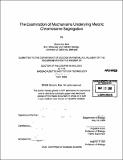The examination of mechanisms underlying meiotic chromosome segregation
Author(s)
Brar, Gloria Ann
DownloadFull printable version (38.81Mb)
Other Contributors
Massachusetts Institute of Technology. Dept. of Biology.
Advisor
Angelika Amon.
Terms of use
Metadata
Show full item recordAbstract
Meiosis is the cell division by which gametes are produced. Meiotic chromosome segregation differs from Mitotic segregation in that one DNA replication phase is followed by two chromosome segregation phases. This allows generation of haploid products from a diploid precursor cell and depends on a number of cellular specializations that allow completion of a reductional segregation phase, in which homologous chromosomes segregate apart. I have investigated several mechanisms that contribute to meiotic segregation, including stepwise loss of meiotic cohesion, proper prophase progression and homolog pairing. I have found that stepwise cohesion loss is regulated by multiple mechanisms, including bulk phosphorylation of the meiotic cohesin Rec8. I also find that homolog linkage resulting from recombination regulates stepwise cohesion loss. Additionally, I present data that Rec8 plays an additional cellular role that is separable from its function as a cohesin. Rec8 is important for assembly of the Synaptonemal Complex (SC) and meiotic prophase progression. Like Rec8's cohesin role, this prophase role appears to be influenced by Rec8 phosphorylation. Finally, I present a basic characterization of the process of homolog pairing in early meiosis. I find that pairing is independent of DNA replication, but depends on cohesins, actin filaments, SC components and DSBs.
Description
Thesis (Ph. D.)--Massachusetts Institute of Technology, Dept. of Biology, 2008. Includes bibliographical references.
Date issued
2008Department
Massachusetts Institute of Technology. Department of BiologyPublisher
Massachusetts Institute of Technology
Keywords
Biology.